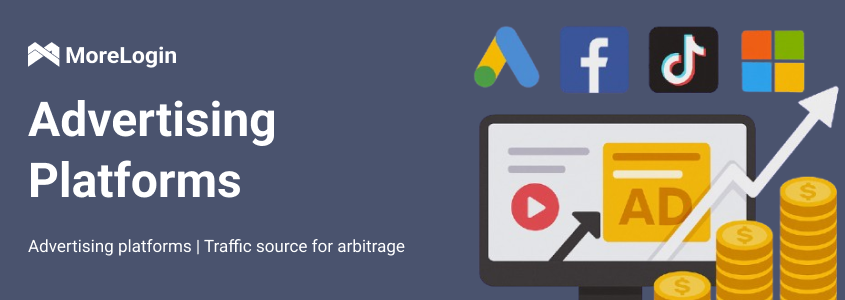
- Product

- Pricing
- Affiliate Program
- Use Cases
- Resource


After choosing a vertical, an affiliate marketer faces task number two: advertising platforms — the choice of a traffic source. A mistake here cannot be afforded, otherwise the entire budget will be drained. Below is an analysis of selecting a source, based on numbers and reality.
The classification of traffic sources by cost can be divided into two types:
Examples: YouTube, Instagram, Telegram, Yandex.Zen, and others.
Promotion here is built on organic reach, recommendations, SEO, or alternative tactics (e.g., viral content). Such channels do not require direct ad spending, but they require time, a systematic approach, and experience. In addition, they are heavily dependent on platform algorithms, which change unpredictably. This makes reach unstable and results less manageable.
This is the classic option: Google Ads, Facebook Ads, TikTok Ads, various DSP platforms, and similar ad networks.
Here the model is simple: you pay — you get impressions. This ensures a high level of control, predictability, and scalability. Paid channels allow you to quickly launch traffic, test hypotheses, and get results within specific timeframes. However, they require budget, setup, and optimization.
Conclusion: Beginners and those working with limited time or experience should bet on paid channels. They deliver quick and manageable results. Organic channels make sense if there are resources for content, an understanding of algorithms, and readiness for a long-term strategy with unstable effects. The optimal approach is to combine both types of sources as you grow.
Key factors:
Active Audience Volume
The higher the number of users in the source, the greater the potential reach and the higher the scalability ceiling.
User Geography
The source must be popular in the regions where you plan to run traffic. Without the right GEO — no tests will help.
Targeting Tools
The more precise the access to the desired audience (by interests, behavior, demographics), the higher the chances of profit. Without targeting — ad spend is meaningless.
Traffic Cost
Focus on real CPM/CPA from cases. It is important not only how much an impression costs but also how much a conversion costs.
Moderation
Strictness, algorithms, rules. The more loyal the system — the easier it is to launch. But don’t forget about risks, especially if you work in gray niches.
Technical Stack (pixels, API, etc.)
The platform must support tools for analytics, tracking, and optimization. Without them, proper scaling is impossible.
Audience Behavior
It is important to understand how users interact with ads: random clicks, skips, misclicks, or conscious attention.
Content Production Effort
Some platforms require minimal creatives (teasers, banners), while others require full video production. This affects launch speed and test costs.
Condition: spending $10K at CPM = $5
That means ~2 million impressions are needed.
Example:
A VK public with 1,000 subscribers → would require 2,000 impressions per user, which is unrealistic.
A source with 10M+ active users — acceptable.
For proper traffic turnover, a source must deliver millions of impressions, not thousands. Otherwise, it is impossible to maintain frequency without audience burnout, and any scaling attempt will hit the ceiling of reach. The smaller the user base, the faster you’ll encounter banner blindness, rising lead costs, and falling conversion rates. In the long run, this kills profitability even with a good offer and creatives.
Targeting tools are a key factor in accurately reaching the target audience. The wider and more precise the toolkit, the higher the effectiveness of advertising.
Facebook has some of the most advanced solutions: a strong machine learning system, automatic optimization, and work with custom and lookalike audiences.
TikTok provides basic targeting by interests and behavioral traits — enough for mass audiences, but not for narrow segments.
Telegram Ads in its current form is limited: no geo-targeting, making it unsuitable for pinpoint tasks, especially if you need to promote something local or niche.
VK Ads remains an effective solution in the CIS market, especially thanks to subscriber parsing and advanced audience collection methods.
Moderation in advertising platforms works differently and affects launch strategy.
In some systems, an AI-first approach is used — for example, in Facebook and TikTok, where most checks are automatic. This speeds up the process but leads to erroneous bans and requires constant testing of wordings and visuals.
In other cases, moderation relies on manual review, such as with Telegram seedings or publishing organic content on YouTube. Here much depends on the individual and their interpretation of the rules.
The safest method is adapting creatives to the platform’s requirements: creating a so-called “safe version” that formally does not violate rules.
Riskier but effective approaches include cloaking, where moderation sees one version of content and users see another, or working through warmed-up accounts and trusted domains, which are less likely to be flagged and pass moderation more easily.
Another option is using the MoreLogin browser, which allows managing multiple accounts across different ad systems. This reduces the risk of linking accounts and simplifies warming or scaling campaigns, especially where moderation considers behavioral factors and history of interaction.
Choosing a traffic source in affiliate marketing is not about luck but about a systematic approach.
To avoid wasting budgets:
Identify where your target audience is located and which platforms can reach them with the required precision.
Analyze placement conditions and calculate approximate CPM using available case data and metrics.
Narrow the pool down to several options with minimal cost and relevant geography.
The final stage is full testing: only through real campaigns can you understand which source delivers the required volume and acceptable cost per conversion.